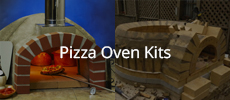Looking good! you must be getting excited to drop in that keystone!
My mortar was dark enough to contrast with the lighter brick, so I just used that to fill in the design I carved with a Dremel.
I had to mortar 2 full bricks together to make my keystone. I used the time while the clamps were on and the mortar was curing to carve and work some mortar into the design. The next morning I double checked that it was holding well. I check it now and again and so far none has landed in a pizza.
I was inspired by RusselI's (UtahBeehiver ) cool design. I didn't spend a lot of time on mine because the artist in me has yet to emerge.
Unless you're going to take a pic and display it next to the oven, few are going to see your efforts; but, I admit to enjoying that I know it's there.
Announcement
Collapse
No announcement yet.
31"/800mm in Eindhoven, the Netherlands: Design critique and build topic
Collapse
X
-
After a week of a lot of bad luck (dead car battery, broken bike gear cable, flat tire ) it was finally possible to get some bricks in...
) it was finally possible to get some bricks in...
Two rows of quarter bricks. The issue of them being too wide didn't really lead to any problems... just that I had quite a few too many. The anchor brick for the last row is now in, so hopefully tomorrow I'll finish that and then it's time for the keystone.
I've seen some really nice designs with prints and engravings on the keystones. I was wondering: what kind of material could I use to color the mortar such that it stays in place and also keeps it contrast?3 Photos
Leave a comment:
-
Wire brush and white vinegar worked pretty well for me to clean up excess mortar; for bigger squeezed out bits, just aggressively scraping with a trowel can often do the trick.Originally posted by Toiletman View Post
Wow, that's pretty quick. I had to gently tap my keystone in place, so I didn't want to risk it. However, I pulled it out today, and indeed quite a bit of mortar leakage. However, one day later it was still easily cleanable so it turned out quite nice. The side supports are a lot worse, I've probably gotta clean them with a power tool... or try to sand them or sth... any tips on cleaning dried up mortar?
Leave a comment:
-
Thanks for your comment UtahBeehiver !
Latest status update: The halfbrick courses are all in and I've been hard at work cutting the quarter bricks. In doing that I've run into a little issue. Actually I'm not sure if it's really a problem, but I'd at least like to share it such that other people don't make the same mistake.
As probably everyone has, I've been using the great calculation sheet by deejayoh. While cutting the bricks I assumed that I had to spread the cuts equally across the full brick. However, that's not really the case: the sheet by default calculates the longest side of the cut brick to be a half or quarterbrick size. As a cutting jig I'm using Chipster's design, flipping the brick after each cut. This results in a long and a short side sharing the full length of the brick --> instead of 'two long sides' as the calculator assumes by default.
This difference is quite small at small angles (lower in the dome), but gets larger and larger the higher up you come. For the half bricks it did not cause any realizable problems, but when cutting the final quarter brick course I was struggling to get the spacing correct, hence I dove in. It now seems that the bricks for course 10 I cut are basically 5mm / 1/8" too long. I've still got to put course 9 in, so I haven't been able to test yet to see if it would really bother me. In the end it would result in more mortar usage, which shouldn't really be a problem. Luckily course 11 hasn't been cut yet, so for that one I can correct.
Lessons learned:- Check the calculator thread more carefully, deejayoh mentions the possibility to adjust the brick width there
- 'Quarter bricks' are really only 'quarter bricks' for course 9, afterwards they become smaller.
Did you guys run into the same issue? Or did you correct for it beforehand in the calculator? I might've just missed this in other posts as the focus while looking through these threads was on understanding the generic concept and creating the cutting jig.4 PhotosLast edited by Toiletman; 06-29-2024, 07:56 AM.
Leave a comment:
-
Nice use of laser level. It is common to see the dreaded droop after clearing the inner arch with your dome courses. Looks like you are right on par.
Leave a comment:
-
Another small update: I got the first 'full round' layer in... it's also the penultimate halfbrick layer. One more to go, which is already cut so hopefully I can put it in tomorrow. After weeks of rain, flooding and cold, now we have a heatwave.. so probably working in very small batches and getting things very wet again. After that it's time to modify the IT to fit the small bricks and see how that goes.
After the large tolerances on the firebricks I was worried about the build going out of whack. Luckily the laser proved that it's worked itself out correctly. there's max 5mm / 1/8" difference in the extremes.3 Photos
- Likes 1
Leave a comment:
-
Wow, that's pretty quick. I had to gently tap my keystone in place, so I didn't want to risk it. However, I pulled it out today, and indeed quite a bit of mortar leakage. However, one day later it was still easily cleanable so it turned out quite nice. The side supports are a lot worse, I've probably gotta clean them with a power tool... or try to sand them or sth... any tips on cleaning dried up mortar?Originally posted by RandyJ View PostHey Toiletman the dome arch I was not very worried about it falling so I think I mat have only waited 45 minutes to maybe 1.5 hrs. It was not very long at all. I was worried I had a bunch of mortar to clean up so once it was solid enough that it was no longer squishier I pulled the form and cleaned up. I had to pound my key stone into place with a deadblow mallet so I knew everything was tight so just made sure nothing was wiggle and went for it. The front arch I waited a bit longer but a big part of that was waiting for a friend to get there to help me lift the vent into place . I had just done the vent arch and then vent like 2hr later so was probably 3 to 4 hours after I had set the arch in place I pulled the form. It was also a tight fit so I was not worried about it moving. I was more worried I would hit it trying to lift the vent into place and knock something loose. This was my experience your mileage may very. I would say do what is comfortable for you. But is should hold just fine in a few hours. The dome braces the walls for you.
Randy
2 Photos
Leave a comment:
-
Hey Toiletman the dome arch I was not very worried about it falling so I think I mat have only waited 45 minutes to maybe 1.5 hrs. It was not very long at all. I was worried I had a bunch of mortar to clean up so once it was solid enough that it was no longer squishier I pulled the form and cleaned up. I had to pound my key stone into place with a deadblow mallet so I knew everything was tight so just made sure nothing was wiggle and went for it. The front arch I waited a bit longer but a big part of that was waiting for a friend to get there to help me lift the vent into place . I had just done the vent arch and then vent like 2hr later so was probably 3 to 4 hours after I had set the arch in place I pulled the form. It was also a tight fit so I was not worried about it moving. I was more worried I would hit it trying to lift the vent into place and knock something loose. This was my experience your mileage may very. I would say do what is comfortable for you. But is should hold just fine in a few hours. The dome braces the walls for you.
Randy
- Likes 1
Leave a comment:
-
You're still going much faster RandyJ but I've finally taken your advice and got the inner arch in today. Went together much better than I expected. How long did you wait to pull the form? I'm assuming at least a day?Originally posted by RandyJ View PostToiletman I don't know if you want to hear it or not but when I did my arches I went with pretty wet mortar. That way it was easier to get the tight joints. Besides you have the form to hold it in place. Once everything has set then you pull the form and clean up.
Randy
For the rest progress has been pretty OK, although as mentioned: slow. Row 5 is in, 6 is halfway and row 7 is cut. I hope that's going to be the first one to cover the arch fully.
I've shared pictures below, some general questions:- I've been using some old towels/sheets to keep the dome moist, and also to specifically wet stones just before mortaring in new ones. This seems to be working pretty ok, especially as adding water directly to the stones just doesn't work anymore on the higher slopes. Is this a common experience? Any other way's of working to consider?
- These higher slopes are starting to need stick to support them. It's rather fiddly work and I don't really have the hang of it yet. My sticks are kind of big compared to what I see around here, and they're quite loose... typically with cleaning the excess mortar I tap a few of them over from bumping into them. Is this a common experience? Or do you guys tap them into place or something?
Leave a comment:
-
Toiletman I don't know if you want to hear it or not but when I did my arches I went with pretty wet mortar. That way it was easier to get the tight joints. Besides you have the form to hold it in place. Once everything has set then you pull the form and clean up.
Randy
Leave a comment:
-
That was a fantastic tip, thanks! Not so much visible progress here, but a lot of bricks were cut:Originally posted by Giovanni Rossi View PostToiletman , you may want to try a technique I got from Russell ( UtahBeehiver ). At the end of your work day, mortar a single brick on your next row and allow it to set overnight. Then, you have a solid anchor to work the next brick against when you start your next work session. Since I didn't lay a lot of bricks each day and I needed to brace each brick the higher I went, I took this advice a little further and worked on multiple rows at a time. At one point my dome looked like steps of a pyramid, but I always had a solid section to tap against.- closing brick course 3 to arch
- closing brick course 4 to arch
- 4th course bricks
- 5th course bricks
- inner arch bricks
Any tips for the arch? It seems like a very challenging thing to do, especially with thin mortar joints, and the need for it to fit and look visually pleasing.
2 Photos
Leave a comment:
-
Toiletman , you may want to try a technique I got from Russell ( UtahBeehiver ). At the end of your work day, mortar a single brick on your next row and allow it to set overnight. Then, you have a solid anchor to work the next brick against when you start your next work session. Since I didn't lay a lot of bricks each day and I needed to brace each brick the higher I went, I took this advice a little further and worked on multiple rows at a time. At one point my dome looked like steps of a pyramid, but I always had a solid section to tap against.
- Likes 1
Leave a comment:
-
Thanks for your input and I fully recognize your struggle with the correct consistency of the mortar and the correct wetness of the bricks. It's quite challenging. Further input below Randy's comment.Originally posted by Giovanni Rossi View PostAs with a brick and mortar wall, I don't believe you have any issues regarding structural integrity. Maybe others could comment on the possibility of spalling of the wider mortar joints in this high-heat environment. My research lead me to trying to make the mortar joints on the inside of the dome as narrow as possible. I worked each brick until I felt brick on brick contact. One of the most problematic things I faced was getting proper consistency with the various cementitious products I used. In order to get the tight joints I wanted, I had to keep the mortar on the wet side. Balancing that with the proper wetness of the bricks was challenging. My technique was to lay a mortar bed for 2-3 bricks and butter the side of the last brick I had set. It was too awkward for me to try to butter a brick before or after I clamped it in the IT. That mortar consistency certainly helped with getting brick on brick contact and squeezing mortar into those tight places. But, I believe I paid a price as the rows became more vertical since I had trouble keeping the bricks in place until the mortar cured.
Thanks for your input as well Randy, I"ll try and get all gaps filled in the coming rows. I just had another look at Ben's Firebrick video on the bricklaying and ordered a pointed trowel as well as a deadblow hammer, my large masonry trowel doesn't let met get close. Ben is also putting hte mortar on the existing row, instead of the new brick, that's what I'll also try.Originally posted by RandyJ View PostYou want to make sure that you are packing the space between the bricks full of mortar. You do not need to have the super tight joints all the way back on the brick. The front edge is where you want to have the nice tight joint and it is not as critical as you move back. I believe that you do want to have the joint fully packed full though. I see your bricks do not look to have any mortar squeezing out of the joints. You want that then just clean up the mess after you are done for the day. Sometimes it is hard to get the mortar all the way to the front of the brick but it is worth a shot. You can use a deadblow hammer to tap the brick into place. I would definitely recommend going through and trying to pack as much mortar into the joints you have done already as possible. It will make for a stronger finished product.
My doubt from seeing Ben's video is that my homebrew mortar does not behave like that at all, I don't think it will flow as much, but instead just transfer the hammer force into the bricks underneath. He also hammers in the bricks sideways, which I accidentally did on my first row. This resulted in the whole row shifting a little bit, so I don't plan to do that at all. Didn't you suffer from your other bricks moving while trying to push in the current one?
Last edited by UtahBeehiver; 05-28-2024, 02:40 PM.
Leave a comment:
-
Toiletman i just had a chance to look at your pictures colser. You want to make sure that you are packing the space between the bricks full of mortar. You do not need to have the super tight joints all the way back on the brick. The front edge is where you want to have the nice tight joint and it is not as critical as you move back. I believe that you do want to have the joint fully packed full though. I see your bricks do not look to have any mortar squeezing out of the joints. You want that then just clean up the mess after you are done for the day. Sometimes it is hard to get the mortar all the way to the front of the brick but it is worth a shot. You can use a deadblow hammer to tap the brick into place. I would definitely recommend going through and trying to pack as much mortar into the joints you have done already as possible. It will make for a stronger finished product. This is one of the reasons that if i ever was to cut another oven I would just bevel the sides and leave everything else square. So much easier to make sure the joints are full. The problem is it makes laying the bricks harder and cutting them harder to try to keep all the joints tight. I know a few have done it but short of that being your goal for personal reasons it will not make a difference in how it performs. As long as you are not using something like heatstop as a mortar as I believe that requires tighter joints but still the back side does not need to be as tight as the front. Make the front fit tight and don't worry about the back. No one will ever see it. You will also want to make sure the front side in the oven is packed full for the joints you have the just wash it clean when you are done. I know I need to crawl inside mine now and touch up a few spots. That is just part of the game.
Randy
Leave a comment:
-
Toiletman There are fellows here with infinitely better masonry skills that I possess who can give you more peace of mind, but here's my 2 cents.Originally posted by Toiletman View Post
So questions about these gaps:
Do they matter?
Structurally my feeling is that there's more than enough contact with mortar to glue the bricks down, as well as the weight and dome shape keeping everything in place?
I've now spent some effort to also fill the gaps on the top and on the outside of the bricks, but my feeling is that that might be a waste of effort? What do you guys think?
As with a brick and mortar wall, I don't believe you have any issues regarding structural integrity. Maybe others could comment on the possibility of spalling of the wider mortar joints in this high-heat environment. My research led me to trying to make the mortar joints on the inside of the dome as narrow as possible. I worked each brick until I felt brick on brick contact. One of the most problematic things I faced was getting proper consistency with the various cementitious products I used. In order to get the tight joints I wanted, I had to keep the mortar on the wet side. Balancing that with the proper wetness of the bricks was challenging. My technique was to lay a mortar bed for 2-3 bricks and butter the side of the last brick I had set. It was too awkward for me to try to butter a brick before or after I clamped it in the IT. That mortar consistency certainly helped with getting brick on brick contact and squeezing mortar into those tight places. But, I believe I paid a price as the rows became more vertical since I had trouble keeping the bricks in place until the mortar cured.
I wanted to maximize thermal mass so I filled the gaps. I typically had a little mortar left over after setting the last brick, so I filled in where needed. However, I didn't have the up front labor for my mortar. Heck, I had enough mortar mix left over that I was able to apply a 1/4" layer over the entire dome.
You're making good progress. If there's anything I've learned from following this Forum it's that these projects are pretty forgiving. Like you said, yours is a hobby project, so enjoy the ride.Last edited by Giovanni Rossi; 05-28-2024, 02:02 PM.
Leave a comment:





Leave a comment: